|
 Secure Site
Secure Site
|
 |
Archive for the 'Yoga Timer' Category
 tranquillity In Buddhism, passaddhi refers to tranquility of the body, speech, thoughts and consciousness on the path to enlightenment. As part of cultivated mental factors, passaddhi is preceded by joy (pīti) and precedes concentration (samādhi).
adapted from wikipedia.org
 Digital Zen Timers, a mindfulness practice tool
Posted in Japanese Inspired Zen Clocks, Now & Zen Alarm Clocks, Progressive Awakening, Yoga Timer
 Sousaku Hanga woodblock print by Yoshida Toshi, ca. 1970 Compassionate Listening Practice by Thich Nhat Hanh
When we speak of listening with compassion, we usually think of listening to someone else. But we must also listen to the wounded child inside of us. The wounded child in us is here in the present moment. And we can heal him or her right now.
Practice: “My dear little wounded child, I’m here for you, ready to listen to you. Please tell me all your suffering, all your pain. I am here, really listening.” If you know how to go back to her, to him, and listen like that every day for five or 10 minutes, healing will take place. … Do that for a few weeks or a few months, the wounded child in you will be healed. Mindfulness is the energy that can help us do this. The Tibetan Bowl Timer will gently bring your practice to an end after 10 minutes.
—Thich Nhat Hanh, from Anger: Wisdom to Cool the Flames
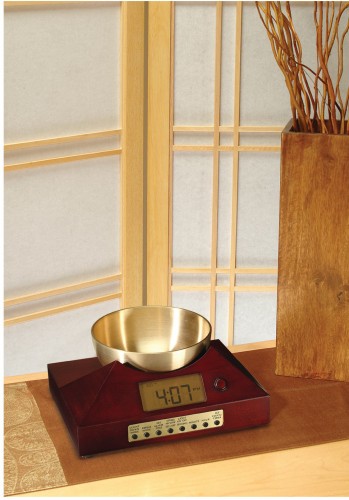 Zen Alarm Clock for a Gentle Awakening with a Bowl Gong and Mindfulness Timer Now & Zen
1638 Pearl Street
Boulder, CO 80302
Posted in Chime Alarm Clocks, Japanese Inspired Zen Clocks, Meditation Tools, mindfulness practice, Natural Awakening, Progressive Awakening, Yoga Timer, Zen Timepiece by Now & Zen, Zen Timers
 The famous moss garden of Saihō-ji. Saihō-ji is a Rinzai Zen Buddhist temple located in Matsuo, Nishikyō Ward, Kyoto, Japan. The temple, which is famed for its moss garden, is commonly referred to as “Koke-dera”, meaning “moss temple”, and is also known as “Kōinzan Saihō-ji”.
The famous moss garden of Saihō-ji is situated in the eastern temple grounds. Located in a grove, the garden is arranged as a circular promenade centered around Golden Pond. The pond is shaped like the Chinese character for “heart” or “mind” and contains three small islands: Asahi Island, Yūhi Island, and Kiri Island. The area around the pond is said to be covered with more than 120 varieties of moss, believed to have started growing after the flooding of the temple grounds in the Edo Period (1603 to 1868).
 Bamboo Zen Chime Clocks & Timers adapted from wikipedia.org
Now & Zen
1638 Pearl Street
Boulder, CO 80302
Posted in Bamboo Chime Clocks, Chime Alarm Clocks, Japanese Inspired Zen Clocks, Meditation Timers, Meditation Tools, Now & Zen Alarm Clocks, Progressive Awakening, Yoga Timer, Yoga Timers by Now & Zen
 Brigitte Mars, author, herbalist, and amazing raw food chef from Boulder, CO Peter’s Fairy Godmother, Brigitte Mars (an herbalist, famous author, and raw food chef from Boulder, CO) just gave him the Yoga Garden Game for his birthday! Our whole family loves to play this game at home and when we travel. We use our Zen Timer/Alarm Clock to practice holding each pose for 5 seconds.
Here are Peter’s favorite yoga Poses:
- Frog Pose
- Snake Pose
- Tree Pose
- Cat Pose
- Cow Pose
- Butterfly Pose
- Downward Facing Dog Pose
- Bridge Pose
- Bamboo Pose
 Yoga with kids in nature
 - Bamboo chime clock and yoga timer
Children love to move their bodies! Yoga improves their ability to concentrate and focus. Yoga helps children to be calm too!
Posted in Chime Alarm Clocks, Now & Zen Alarm Clocks, Yoga Timer, Yoga Timers by Now & Zen, Zen Timers
 How Do We Find Balance in Life - Harunobu Suzuki, A girl Collecting Chrysanthemum Dem by the Stream The art of life balance requires creativity. If you push too hard you will miss its subtle rewards. Navigating easily through life requires a sense of curiosity and playfulness, like that of a child. This doesn’t excuse you from taking life seriously, simply that you release the illusion that you can control everything. By exerting control over everything, you may end up limiting yourself. The art of life balance requires dedicated time for having fun and observing the world around you. You may be surprised at what you find if you do.
 Meditation - A Stillness Practice Try a Stillness Practice Like Meditating:
Meditation is generally an inwardly oriented, personal practice, which individuals do by themselves. Meditation may involve invoking or cultivating a feeling or internal state, such as compassion, or attending to a specific focal point. The term can refer to the state itself, as well as to practices or techniques employed to cultivate the state. There are dozens of specific styles of meditation practice; the word meditation may carry different meanings in different contexts. Meditation has been practiced since antiquity as a component of numerous religious traditions. A 2007 study by the U.S. government found that nearly 9.4% of U.S. adults (over 20 million) had practiced meditation within the past 12 months, up from 7.6% (more than 15 million people) in 2002.
Although meditation can be done in almost any context, practitioners usually employ a quiet, tranquil space, a meditation cushion or bench, and some kind of timing device to time the meditation session. Ideally, the more these accoutrements can be integrated the better. Thus, it is conducive to a satisfying meditation practice to have a timer or clock that is tranquil and beautiful. Using a kitchen timer or beeper watch is less than ideal. And it was with these considerations in mind that we designed our digital Zen Alarm Clock and practice timer. This unique “Zen Clock” features a long-resonating acoustic chime that brings the meditation session to a gradual close, preserving the environment of stillness while also acting as an effective time signal. The Digital Zen Clock can be programmed to chime at the end of the meditation session or periodically throughout the session as a kind of sonic yantra. The beauty and functionality of the Zen Clock/Timer makes it a meditation tool that can actually help you “make time” for meditation in your life.
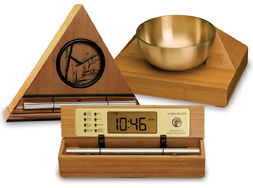 Timers for Meditation and Yoga - Progressive Acoustic Chimes
Now & Zen’s Meditation Timer Store
1638 Pearl Street
Boulder, CO 80302
(800) 779-6383
Posted in Bamboo Chime Clocks, wake up alarm clock, Well-being, Yoga Timer, Yoga Timers by Now & Zen
 Choose a Gentle Zen Timer for Your Partner Yoga Practice Partnering up in yoga class can deepen your practice and connect you to yourself and your fellow yogis.
We were only a few minutes into the yoga class when the teacher uttered the five words I dread hearing: “OK, everybody, find a partner!” As we students sized up one another with varying degrees of wariness, the teacher demonstrated what she wanted us to do by leaping lightly onto the thighs of a supine volunteer and balancing there, as gracefully as a cat, her feet grounding and rotating her partner’s thighs inward.
Full disclosure: My approach to partnering exercises in yoga class has generally been of the “Lie back and think of England” variety, though I usually participate as gamely as I can. But this particular caper was just too much for my inner Woody Allen. What if my partner or I slipped and fell? What if I had bone density issues I didn’t know about? What if my partner outweighed me, or I her? What about my bad knee? Where were the feet supposed to go? Concerned about my safety, and uncomfortable turning to the person next to me and saying, “It’s nice to meet you. I’m now going to place my bare feet on your thighs,” I declined to participate.
Unlike “partner yoga,” in which two people come together to create a single pose, often practiced with a friend or significant other, “partnering” takes place when your teacher asks you to consider the student next to you as a human prop to help you get into a pose more fully, isolate a particular action, or help you balance. A teaching tool in many styles of yoga classes, partnering tends to inspire strong feelings among practitioners: Mention the subject to a group of yoga students, and the room is likely to erupt in exclamations as people tell their stories of awkward moments, contact with another person’s sweat or stinky feet, and even injuries.
 Dos damas paseando - artista Shunshô Katsukawa Here at the Yoga Journal office, where we practice yoga together every day, we ask that our teachers not do partnering exercises in class—not all of us are comfortable with the degree of physical intimacy involved in sharing sweat with a supervisor, or gripping a co-worker from behind. But the frequency of partnering exercises in the other classes I attended made me wonder whether my resistance to them could be holding me back. What was I missing by participating reluctantly, or opting out entirely? When I started asking around, I discovered that there’s no simple answer to that question, since partnering exercises themselves, and people’s attitudes toward them, vary greatly. A few teachers told me that they never teach partnering exercises in class, because of the risk of injury. For other teachers and practitioners, asking, “How do you feel about partnering?” was like asking, “How do you feel about yoga?”—so central does the one practice seem to be to the other. Still others described partnering, when done safely and skillfully, as a useful tool for deepening your practice.
Use our unique “Zen Clock” which functions as a Yoga Timer. It features a long-resonating acoustic chime that brings your meditation or yoga session to a gradual close, preserving the environment of stillness while also acting as an effective time signal. Our Yoga Timer & Clock can be programmed to chime at the end of the meditation or yoga session or periodically throughout the session as a kind of sonic yantra. The beauty and functionality of the Zen Clock/Timer makes it a meditation tool that can actually help you “make time” for meditation in your life. Bring yourself back to balance.
adapted from YogaJournal.com by Charity Ferreira
 Yoga Timer for Partner Yoga in Bamboo Now & Zen’s Yoga Timer Store
1638 Pearl Street
Boulder, CO 80302
(800) 779-6383
Posted in Meditation Timers, Meditation Tools, mindfulness practice, Yoga Timer, Yoga Timers by Now & Zen
 Meditation Timers & Clocks - Utgawa I’m not exactly clear on how they did it. Something about taking Group No. 1 over here, hooking them up to a nifty array of happyfun electrodes and letting them begin their deep and experienced meditation practice, and then, at some point, suddenly blasting the sound of a woman screaming in distress right into their prefrontal lobes like a swell little ice pick of terror.
And then the researchers observed which parts of the meditators’ brains lit up and noted that it was the hunks related to empathy and compassion and also the parts that say, “Hey, that screaming can’t be good, and I think I’ll get up and go help that poor woman.”
Then they did a similar thing with Group No. 2, only minus most of the experienced meditation part. And when this group heard the same woman screaming in distress, their brains also lit up, only this time it was those parts that said, “Huh, chick screaming in distress, let us now reach for the remote control and turn up the volume on this delightful episode of ‘How I Met Your Mother’ to drown out that obnoxious sound, because, you know, how annoying, and, by the way, I could really use a Bud Light and some guns right about now.”
It’s not exactly news
I might be oversimplifying. Or exaggerating. No matter, because the fact remains it is was one of those nice studies that deigns to reveal a helpful factoid that millions of people, and thousands of teachers and gurus and healers, have known for roughly a billion years.
It is this: Deep meditation, the act of stilling yourself and calming the mind and working with the breath and maybe reciting a mantra or clearing your chakras or running a nice bolt of golden energy up and down your spine, can have a positive effect on your worldview, can inject some divine love juice into your core and make you more sympathetic, kinder, more apt to feel a natural inclination toward generosity and compassion and helping people who might be, you know, screaming.
I know. Totally shocking.
It’s a small study that goes handily with the umpteen similar bits of research recently, all of which seem to indicate some other famously healthful aspect of meditation: stress relief, illness prevention, life extension, emotional stability, improved sleep, increased productivity, better orgasms, fewer ingrown hairs, brighter sunshine, better gas mileage and also merely learning to sit still and shut up once in a while, which I can promise you will make your wife and your siblings and your kids and your dog and even your own squealing manic ego very happy indeed.
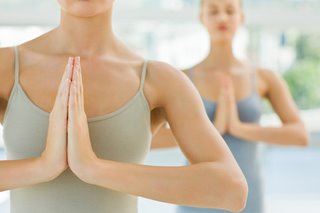 Meditation Timers and Alarm Clocks with Soothing Chimes Did you already know of such benefits? I’m guessing you did. Here in NorCal, meditation is so widespread and normalized it’s available in the Whole Foods bulk aisle. I do believe over in Berkeley and parts of Marin County you are actually required by law to meditate at least twice a week atop your handmade zazen cushion in your Zen rock garden next to your carefully restored BMW 2002 as you listen to very cheesy wind chime music on an iPod-enabled Bang & Olufsen 5.1 home theater system just before you pour yourself a nice glass of Sonoma Chard, or the police come and politely take away your Tibetan Nag Champa incense holder for a month.
Just a froufrou thing
Ah, but I suppose this is not the case nationwide. I imagine the practice is still widely considered, even after all these millennia and all these studies and teachers and perky New Age bookstores and all the obvious proof that meditating has little, really, to do with religious belief, to be some sort of hippie cultish pagan anti-Christian satanic froufrou thing more aligned with monks and bells and Hindu wackiness than with everyday gul-dang gun-smokin’ ‘Merkin life.
And hence I guess we still need studies like this to lend validation to a timeless wisdom that, if disseminated more widely, could improve the health of the nation. Hey, every little bit helps, right? Enough studies and enough serious medical journals bring alternative ideas like meditation to the fore and maybe, just maybe, we could nudge the culture away from mania and obsession and road rage and a zillion Prozac prescriptions as the only means of coping with the trudging maelstrom of daily existence.
It can’t hurt. Because the problem is that we as a culture are still very much trained, beaten, shaped from birth to never, ever, no matter what you do, calm down and breathe more consciously and try to live more fully in the moment you are in. Present-time awareness? Breathwork? Cultivating a sense of loving kindness? Save it for the New Age Expo, hippie. Real men live in some neurotic-psychotic state of need and regret and wishful thinking, all undercut with a constant shiver of never-ending dread. Isn’t that right, Mr. President?
But meditation, well, it abides none of that noise. It brings you into the here and now and plops you into the lap of stillness and reminds you that there is more to it all, that you have incredible power to change your own habits and tendencies and daily love quotients, that God often speaks in whispers and flutters and quiet little licks on your heart and only when you dial down your raging internal dialogue can you actually hear what she’s trying to say. What’s not to like?
Of course, you need no scientific study to learn any of this for yourself. But who knows, maybe there will come a day when you can stroll into just about any doctor’s office and she will say, what’s that? You say you’re getting weird rashes and heart palpitations and you feel overwhelmed? You have rage issues? Melodrama? Warmongering and pain and fear of the Other? Have a glass of wine. Eat better. Exercise. More sex, less whining, better books.
And oh yes, also this: Once a day, just for a few minutes, go sit very still, close your eyes, shut up and breathe.
Use our unique “Zen Clock” which functions as a Yoga & Meditation Timer. It features a long-resonating acoustic chime that brings your meditation or yoga session to a gradual close, preserving the environment of stillness while also acting as an effective time signal. Our Yoga Timer & Clock can be programmed to chime at the end of the meditation or yoga session or periodically throughout the session as a kind of sonic yantra. The beauty and functionality of the Zen Clock/Timer makes it a meditation tool that can actually help you “make time” for meditation in your life. Bring yourself back to balance.
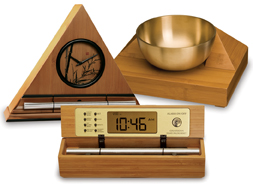 Meditation Timers and Clocks -- From Now & Zen adapted from SFgate.com by Mark Morford columns with inset links to related material can be found at sfgate.com/columnists/morford.
Now & Zen – The Zen Timer and Alarm Clock Store
1638 Pearl Street
Boulder, CO 80302
(800) 779-6383
Posted in Bamboo Chime Clocks, Meditation Timers, Meditation Tools, mindfulness practice, Yoga Timer, Zen Timers
 Guided Meditation Practice limitless awareness and let yourself be as infinite as the heavens.
This is the third guided meditation in a series that started two days ago:
Turn your attention from the surface of the lake toward the sky itself. Then imagine shifting your gaze from the reflections, the passing phenomena, to the sky within which they all arise and pass away. The sky is boundless, limitless. It contains everything that arises. The horizon is only a perceptual or conceptual boundary that can never be reached. Even on the cloudiest day, the sky is luminous above the clouds, pervasive, limitless, and free.
Awareness has the qualities of luminosity and limitlessness. It is present always, behind, between, and beyond all the ever-changing phenomena. Whenever you catch yourself identifying with the mental “clouds,” simply shift your identification from the clouds to the sky itself. Realize that what you’ve been seeking is what you already are and have always been! Big Sky Mind opens us to seeing that our true nature is this awareness within which all experience arises and passes away.
adapted from Yoga Journal by Frank Jude Boccio
Although meditation can be done in almost any context, practitioners usually employ a quiet, tranquil space, a meditation cushion or bench, and some kind of timing device to time the meditation session. Ideally, the more these accoutrements can be integrated the better. Thus, it is conducive to a satisfying meditation practice to have a timer or clock that is tranquil and beautiful. Using a kitchen timer or beeper watch is less than ideal.
And it was with these considerations in mind that we designed our digital Zen Alarm Clock and practice timer. This unique “Zen Clock” features a long-resonating acoustic chime that brings the meditation session to a gradual close, preserving the environment of stillness while also acting as an effective time signal.
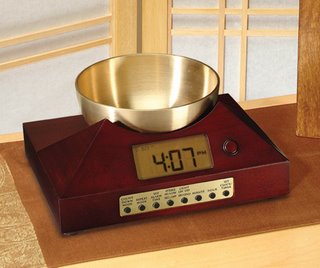 Meditation Timer with Tibetan Bowl Now & Zen – The Meditation Timer Store
1638 Pearl Street
Boulder, CO 80302
(800) 779-6383
Posted in yoga, Yoga Timer, Yoga Timers by Now & Zen
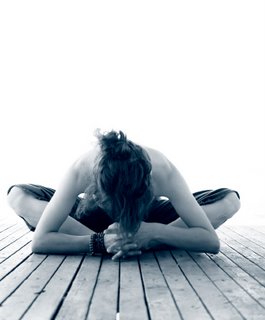 yoga Yoga can be a powerful healing tool for overcoming back pain. But there are times when your practice can do more harm than good. “Too often, students don’t back off a pose until there’s pain,” says Jamie Elmer, a yoga instructor in Boulder, Colorado. “Hurting even just alittle bit is a sign that you have to change something.” Elmer challenges students to answer this question: Why are you coming to yoga? “Are you coming for a distraction from something else? That’s what TV is for. A yoga practice without mindfulness can lead to injury quickly.”
If you have a history of lower back pain, keep these do’s and don’ts in mind when you practice, says Elmer:
DO vary the intensity of your practice. “If we do anything repetitively, day after day, and we haven’t built up the internal strength for that activity, the body won’t be ready for it, and injury will result,” says Elmer. Like any type of exercise, mix up the style of yoga you practice. If you do a vigorous, Ashtanga class one day, seek out a more meditative and calming class the next, so you’re not repeating strenuous movements too often.
DON’T go into any pose to your fullest range of motion. “When you’re in that kind of extreme, you’re not using muscle control,” she says. The result? Risky joint compression in your hips, knees, and spine.
DO use your abdominal muscles and bend your knees when going into a forward bend to prevent overstretching in your lower back.
DO use your abs and keep your legs strong in back-bending poses, including cobra and upward-facing dog.
DON’T twist with a rounded spine. “More important than how deeply you can twist is how long your spine is when you do,” says Elmer.
adapted from Natural Solutions, October 2009
Use our unique “Zen Clock” which functions as a Yoga Timer. It features a long-resonating acoustic chime that brings your meditation or yoga session to a gradual close, preserving the environment of stillness while also acting as an effective time signal. Our Yoga Timer & Clock can be programmed to chime at the end of the meditation or yoga session or periodically throughout the session as a kind of sonic yantra. The beauty and functionality of the Zen Clock/Timer makes it a meditation tool that can actually help you “make time” for meditation in your life. Bring yourself back to balance.
 Yoga Timers with gentle chimes Now & Zen – The Zen Timer and Alarm Clock Store
1638 Pearl Street
Boulder, CO 80302
(800) 779-6383
Posted in yoga, Yoga Timer, Yoga Timers by Now & Zen
Research published in the last two years shows that certain slow activities–like gentle yoga or gardening–can reduce your stress level and blood pressure and improve your body’s ability to regulate sugar. Past studies have shown that other habits like meditation can help reduce chronic pain and enhance mental clarity. The first step to finding “slowness”is to clear some room in your life–watch less TV or spend less time browsing at the mall. “Jettison the clutter that clogs up your schedule,” says Carl Honoré, author of In Praise of Slowness (HarperOne, 2004). “When you focus on the things that are important at work or at home you can enjoy those things more,”he says. You can also take a more relaxed approach to the things you already do and adopt new habits that require mindfulness. “It’s one thing to say you’re going to slow down, but a slow hobby helps you put those words into practice,” says Honoré. To get you started we’ve come up with seven ways to destress and reenergize.
 gardening is a great mindfulness practice that cultivates stillness of mind 1. Become a Gardener
Caring for flowering plants may help you relax and get grounded. In 2004, researchers at Japan’s Utsunomiya University found repotting plants lowered fatigue and promoted physiological relaxation in study participants, and that working with flowers seemed to have a stronger positive effect than working with nonflowering plants.
HEALTH BENEFITS Research shows that exposure to plants–and even just looking at them–can reduce blood pressure, increase concentration and productivity, and help you recover from illness, says Andy Kaufman, Ph.D., assistant professor of tropical plant and soil sciences at the University of Hawaii in Honolulu. He cites a classic 1984 study, published in Science, which showed that even the view of a green garden helped surgical patients recovering from gall bladder surgery. Among a group of 46 patients in a Pennsylvania hospital, the 23 who had rooms with windows facing greenery had shorter postoperative stays and needed fewer pain–relieving analgesics than the 23 whose windows faced a brick wall.
GETTING STARTED If you live in an apartment or don’t have much room to garden, invest in the EarthBox (earthbox.com), a self–watering container garden that comes with potting soil and fertilizer. “Even if you have a brown thumb, you can grow things [in it],”says David Ellis, American Horticulture Society spokesperson. You could also join a community garden; visit ahs.org, the American Horticulture Society’s website, for more info.
 yoga helps to slow us down 2. Practice Slow Yoga
Slow yoga emphasizes one drawn–out breath for each movement you make. Like tai chi, it uses many repetitive flowing moves. “When you practice slow yoga, you create more awareness between mind and body,”says Beth Shaw, founder of Yoga Fit Training Systems in Los Angeles. This creates a deep sense of stillness and helps develop patience and lower stress, she adds.
HEALTH BENEFITS Last year, researchers in Sweden and India showed that practicing yoga can reverse the negative effects of high blood pressure, obesity, and high blood sugar. The studies, published in the journal Diabetes Research and Clinical Practice, showed reduced waist circumference, blood pressure, blood sugar, and triglycerides (the chemical form of fat cells) and higher HDL (so–called good cholesterol) levels in a control group that practiced yoga versus a placebo group.
GETTING STARTED To find a Slow Yoga class near you visit yogafit.com or inquire at your local yoga studio. You might also consider restorative or yin yoga, two other gentle forms of the practice.
 Take a nap 3. Take a Nap
You snooze, you win, according to a Harvard study published last year in The Archives of Internal Medicine. Researchers revealed that people who regularly napped at least three times a week for an average of 30 minutes had a 37 percent lower risk of heart attack than those who didn’t nap. “It shows that napping is an important preventive strategy just like regular exercise, eating right, and not smoking,”says Sara C. Mednick, Ph.D., author of Take a Nap! Change Your Life (Workman, 2006).
HEALTH BENEFITS A daily nap also boosts serotonin, says Mednick, which may lead to improved memory and performance. Napping can even contribute to weight loss, according to a study in the American Journal of Physiology, Endocrinology, and Metabolism in 2007. That study looked at hormone levels in 41 men and women who were part of a seven–day sleep–deprivation experiment. Those allowed to nap for two hours following a night without any sleep showed a significant drop in cortisol, a hormone related to high levels of stress, and a complement of growth hormone, which helps regulate insulin and fat storage. Researchers concluded that a midafternoon nap improves alertness and performance and reverses the negative metabolic effects of sleep loss.
GETTING STARTED The best time to nap is between 1 p.m. and 3 p.m., but a 15– to 20–minute power nap at any time can help. Set your Zen Alarm Clock for 20 minutes. Close the office door and take a snooze, or find a quiet place where you feel safe. Nap on weekends, Mednick says. “Just don’t use the weekend to catch up on sleep lost in the week.”Check with your doctor about napping if you’re being treated for insomnia.
4. Start a Slow Hobby
 learning to paint Hobbies that require mindful, solitary activity–such as knitting, painting, sculpting, crocheting, or quilting–can act as a brake on your hectic pace.
HEALTH BENEFITS “Slow hobbies help you cultivate the lost art of concentration and being in the moment. They have a meditative quality to them,”says author Carl Honorè. “And that calming effect goes beyond the act itself. Maintaining that inner stillness enables you to negotiate the fast–moving waters of the rest of your day.”
GETTING STARTED Sixty–four percent of people who knit or crochet say they use these crafts to help them reduce stress and relax, according to the Craft Yarn Council of America. Visit craftyarncouncil.com for information. To learn about drawing, visit drawspace.com. Check with a local college or community center for other craft classes.
5. Eat Slowly
Eating too fast creates stress in the body, says nutritionist Marc David, author of The Slow Down Diet (Healing Arts Press, 2005). That causes a spike in cortisol and insulin, which in turn diminishes your ability to burn calories and makes you more likely to gain weight. Eating quickly also leads to overeating. “The brain demands more food if it doesn’t have time to register its needs for taste, aroma, and satisfaction,”says David.
HEALTH BENEFITS Taking time to eat creates a relaxation response, which means you’ll have fewer digestive complaints and your body will be able to take in the nutrients it needs. Plus “we make better food choices, and we know when to stop,”he adds.
GETTING STARTED To ease the pace, double the time you spend on your meals; for example, if you usually eat breakfast in five minutes, stretch it out to ten. “Focus on your food: Taste it, enjoy it, notice it, savor it,”says David. “Find relaxed time between bites by slowing down your internal conversation. Let go of any sense of urgency, and allow the moment to be sensual.”The cooking process can help you slow down too, says David. “Instead of microwaving something, make a soup from scratch.”
6. Do One Thing at a Time
A lot of us believe we get more done by multitasking. But research at the University of Michigan published in the Journal of Experimental Psychology in 2001, shows the opposite is true. “If you concentrate on one task at a time, you get more done faster and make fewer mistakes,” says David E. Meyer, director of the Brain, Cognition, and Action Laboratory at the University of Michigan.
HEALTH BENEFITS Taking on chores one at a time reduces chronic stress and protects your short–term memory, which comes under fire if the brain is overtaxed.
GETTING STARTED To curb outside distractions and focus better, set aside time when you can concentrate on one activity from start to finish. For example, check e–mail once an hour and turn off your instant messaging; let your phone messages go to voice mail and only check them occasionally throughout the day.
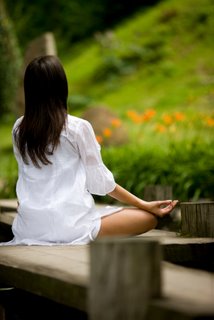 practice meditation in order to slow down 7. Meditate
“Meditation teaches us to focus,”says Steven Hartman, director of professional training at the Kripalu Health and Yoga Center (kripalu.org) in Stockbridge, Mass. “All day your mind is chattering. When you meditate, you can hear your own inner wisdom.”
HEALTH BENEFITS Studies have shown that practicing meditation also improves blood pressure, fortifies the immune system, and promotes a sense of well–being. “A daily meditation practice can bring body, breath, mind, and spirit into balance,”says Hartman.
GETTING STARTED Check out a program like Transcendental Meditation. (See tm.org.) Or begin at home: “Put an egg timer on and stay with your breath for just two and a half minutes,”says Hartman. “Keep your spine tall and straight and allow the breath to be natural.”If you’re seated on the floor, a cushion can raise your pelvis and bring your spine into a natural position. As you get comfortable with the practice, you can increase your time to 15 or 30 minutes a day.
adapted from Natural Health Magazine, by Chrystle Fiedler
One of the ultimate Zen like experiences is waking-up from a great slumber refreshed and energized. Your mind and body are harmoniously one, both alert and focused. Having a refreshed mind and body are two keys to a natural and Zen lifestyle. Waking up in the morning should not be a loud and abrupt awakening, but rather it should be a peaceful positive experience. The right natural alarm clock can transition your deep and tranquil sleep into a serene start to consciousness. Imagine a long-resonating Tibetan bell-like chime waking you up to a beautiful morning experience.
The right alarm clock can be the most beneficial investment for you. With our Now & Zen natural alarm clock you are awakened more gradually and thus more naturally. Now & Zen is focused on creating a naturalistic lifestyle, and our clocks are an example of our philosophy.
 Zen Meditation Timers with Soothing Chime Now & Zen – Soothing Chime Alarm Clock & Timer Store
1638 Pearl Street
Boulder, CO 80302
(800) 779-6383
Posted in Chime Alarm Clocks, intention, Meditation Timers, Meditation Tools, mindfulness practice, Natural Awakening, Now & Zen Alarm Clocks, sleep, Sleep Habits, wake up alarm clock, Well-being, yoga, Yoga Timer, Yoga Timers by Now & Zen, Zen Alarm Clock, Zen Timers
« Previous Entries
Next Page »
|
|
|
|